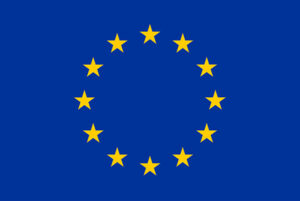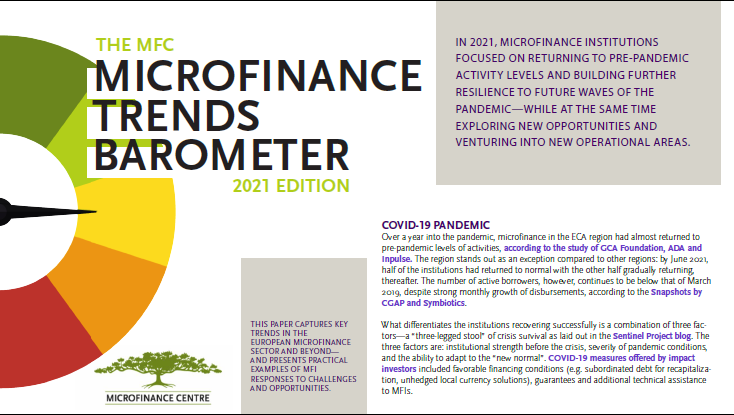MFC Barometer of Trends in Microfinance – 2021 Edition
In 2021, the efforts of microfinance institutions focused on recovering to their pre-Covid-19 levels of activities and on building further resilience to the upcoming waves of the pandemic, while at the same time exploring new opportunities and venturing into the new areas of operations.
The following is a brief summary of the trends seen in the European microfinance sector and beyond and presents practical examples of MFI responses to challenges and opportunities.
Covid-19 pandemic
Over a year into the pandemic, microfinance in the ECA region had almost returned to the level of activities as before the pandemic, according to the study of GCA Foundation, ADA and Inpulse. The region stands out as an exception compared to other regions – by June 2021, half of the institutions have returned to normal with the other half gradually returning, too. The number of active borrowers, however, continues to be below that of March 2019, despite strong monthly growth of disbursements, according to the Snapshots by CGAP and Symbiotics.
What differentiates the institutions recovering successfully is the combination of three factors, a ‘three-legged stool’ of crisis survival as laid out in the Sentinel Project blog. The three factors are institutional strength before the crisis, severity of pandemic conditions, and the ability to adapt to the “new normal”.
Covid-19 measures offered by impact investors included favorable financing conditions (e.g. subordinated debt for recapitalization, unhedged local currency solutions), guarantees and additional technical assistance to MFIs.
In the regions, Balkan microfinance saw a lot of resilience, with MFIs successfully re-starting their activities having adapted their procedures to the new conditions. In Bosnia and Herzegovina, a government guarantee scheme accessible to some MFIs was designed to support the survival of businesses. A new guarantee scheme is needed now to support the recovery of firms. In Albania, the pandemic served as a deep stress test and proved how indispensable the MFIs are in providing financing to MSMEs in difficult times.
In Romania, the quality of the portfolio under moratoria until December 2020 remained strong in 2021 with only 0.67% of the Dec 2020 portfolio being overdue for over 30 days as of April 2021. Microfinance institutions continue digitalizing the lending process, with 80% of MFIs exchanging documents with clients through digital channels and 60% of MFIs conducting loan application assessment, analysis and approval virtually.
Some of the solutions introduced by MFIs during the lockdown became an everyday practice later on. Examples include the delivery of coaching and training via digital channels, and communication with clients via Facebook Messenger and WhatsApp in Belgium. The same MFI also continued using an FAQ bot, but changed the theme from government measures to entrepreneurship support. Another MFI in Romania introduced a new service called ‘Digital Mentor’ with a dedicated staff helping clients in using digital tools for microbusiness.
In the Caucasus, the Georgian microfinance sector received support from the National Bank of Georgia through liquidity measures (swap instruments), refinancing products for MFIs, inclusion of MFIs in a state guarantee program and relaxed capital requirements. In Azerbaijan, the government also implemented the stimulus package, lowered payment services charges and engaged in dialogue with the business community through business associations.
In Central Asia the impact of the pandemic was mixed. In Tajikistan, the number of microfinance institutions went down from 73 to 63, as several smaller MFIs were not able to meet the pandemic challenges. Larger MFIs with contingency plans prepared in advance fared better, as they focused on implementing the actions laid out in the plan. As elsewhere, digitalization accelerated, with significantly increasing numbers of online repayments and mobile loan applications. MFIs see new opportunities in serving the youth thanks to their interest in adopting new technologies.
Observe the trends
- The Balkans and Eastern European Regional Roundtable – #SFV2021 session
- The Caucasus and Central Asia Regional Roundtable – Part 1 and Part 2– #SFV2021 session
- Impact Investor Forum – #SFV2021 session
- Microfinance in Europe: Survey Report (2020 Edition) – Chapter 3.9 on the impact on COVID_19 pandemic on MFI operations
- Benchmarking Microfinance in Romania (2019-2020)
- Inclusive Finance and the Pandemic – #SFV2021 session
- Snapshots: MFIs During the COVID-19 Crisis – CGAP and Symbiotics
- The Sentinel Project
- COVID-19 Observatory – GCA Foundation, ADA and Inpulse
See the practical examples of solutions and approaches
- Microfinance in the time of Covid-19: what did we learn? – #SFV2021 session
- Impact of the COVID-19 Pandemic on Microfinance Clients in Europe – webinar on 30/09/2020
- Impact of the COVID-19 Pandemic on Microfinance institutions in Europe – webinar on 7/1-/2020
- Impact of COVID-19 Pandemic on the Microfinance Sector in Europe – MFC research paper 2020
Digitalization
The pandemic sped up the digitalization process of microfinance institutions as it became clear that distance communication and remote work not only solve the immediate problem of mobility restrictions during the lockdown but are also a useful solution to the challenges of low outreach, poor targeting and ineffectiveness of legacy information systems. As pinpointed by the industry experts during the Digital Trends session at the Social Finance Vibe conference, while digitalization brings opportunities for improving financial inclusion, offers new types of products through partnerships with fintechs, and brings the benefits of big data use, digitalizing financial services also carries risks of digital exclusion and data privacy breaches.
Microfinance institutions continue to introduce new solutions to serve clients and new internal systems to streamline the processes. Social media became a powerful tool for MFIs to communicate with their current and potential clients. An example of an MFI in Moldova shows that a well-designed social campaign can reach out to half of the population in the country. With a targeted marketing campaign the MFI was able to reach out to a smaller number of well-profiled customers which resulted in good quality loan applications with a high conversion rate.
While online loan application is already a standard for the majority of MFIs the next steps of the customer journey also become digital with almost fully digital to fully digital loan products for individuals and businesses already available on the market.
While digitalizing the customer journey many MFIs make sure that they do not lose the personal touch.
Another interesting development is the switch from legacy IT systems to end-to-end loan management systems which allows for streamlining internal processes and gives room for future upgrades.
New types of financial services are also added, where regulations allow the MFIs to provide more than just loans. Digital payments, so much needed in the times of the pandemic, have become part of the MFI offering.
Internally, digitalization requires upskilling the staff of microfinance institutions on all levels – from top level managers understanding the core concepts and opportunities, to back-office staff using the solutions and to field staff explaining their use to clients. MFC’s series of webinars #DigLitBootcamp in English and Russian provided plenty of knowledge from IT experts and from MFIs already advanced in digitalization.
A series of interactive webinars for leaders “Leaders in digital era” aimed at developing soft skills, such as using emotional intelligence and managing intergenerational teams.
#BootcampLabs provided hands-on experience to overcome the challenges of building a solid online presence for their organizations and further developing their practical know-how in online marketing.
Observe the trends
- Digitalization key trends for microfinance sector – #SFV2021 session
See the examples of the solutions and approaches
- Meet the Leaders: MicroInvest Digital Marketing – #SFV2021 session
- Meet the Leaders: Digitalization in Mikrofin, Bosnia and Herzegovina – #SFV2021 session
- Digital loan product at Mikrofond – from 13:33 – 23.36 min
- Meet the Leaders: Digital Payments in Alter Modus – #SFV2021 session
- End-to-end loan management system at Qredits – from 09:20 – 13.26 min
- Meet the Leaders: Digital and Personal – Mikra, Bosnia and Herzegovina – #SFV2021 session
- Meet the Leaders: KMF Digitalization Pathway – #SFV2021 session
- Meet the Leaders: Automation in SME Lending – Noviti Finance – #SFV2021 session
Learn, practice and apply
- Learn basic concepts of digitalization – #DigLitBootcamp in English and Russian
- Practice soft skills to successfully operate a digitalized institution – Leaders in Digital Era
- Solve the challenges you encountered while implementing digital solutions – Bootcamp Labs
Business models evolution
In reaction to the Covid-19 pandemic many MFIs introduced changes to their business models, adapting products and services, delivery models and financing structures to the new situation. While some changes were only temporary for the duration of the lockdown, others became new permanent features of the MFIs’ operations. Access to new sources of funding, and new types of products are examples of permanent business model changes. The pandemic also spurred the acceleration of digital transformation of several MFIs. Outside the microfinance sector, technology allows other types of institutions, such as fintechs, to engage in providing finance to entrepreneurs and vulnerable groups.
See the examples of the solutions and approaches
- Meet the Leaders: Microfinance and future developments – Inpulse, Belgium – #SFV 2021 session
- Meet the Leaders: Automation in SME Lending – Noviti Finance, Lithuania – #SFV 2021 session
- Meet the Leaders: Our Business Transformation – FINCA Armenia – #SFV 2021 session
- Meet the Leaders: Microfinance and Equity Products – Crystal, Georgia – #SFV 2021 session
Client digital business skills
The pandemic has strengthened the need to rethink non-financial services offered by MFI – both in terms of their scope and the delivery model. Many MFIs observe the need to assist their clients in becoming more digital, not only to access financial services but also to run their business – using digital channels for marketing and sales. Several MFIs already engage in educating their clients about social media use, e-commerce and other solutions.
Other MFIs develop digital channels for providing business development resources for farmers or for microentrepreneurs, so that educational materials can be accessed from everywhere at any time.
There are also examples of e-commerce platforms set up by an MFI to create a marketplace for its clients.
Observe the trends
- Small Goes Digital – ILO research paper
See the examples of the solutions and approaches
- Strengthening Clients’ Digital Business Skills – #SFV2021 session
- Online resource platform for farmers – FED Invest, Albania
- Online resource platform for entrepreneurs – Lider, Bosnia and Herzegovina
- Learning platform for entrepreneurs – KEPA/microSTARS, Greece, ABC Foundation, FED Invest
- Practical sheets – Adie France
- e-commerce platform for clients Adie, France
Green microfinance
Globally, efforts to mainstream environmental responsibility have focused on finalizing the Green Index 3.0 – a tool to assess environmental performance of financial institutions and to guide the improvement of environmental strategies by promoting standards and essential practices.
Developed by the Green Inclusive and Climate Smart Finance Action Group (GICSF AG) at e-MFP, the Green Index 3.0 launch was accompanied by a series of webinars for European MFIs to promote green microfinance and the use of tools. Additional resources are available on the GICSF AG’s website.
Microfinance institutions continue to improve their environmental performance on various levels, starting from developing environmental strategies, through building institutional culture, to innovative products and awareness raising activities among microfinance clients.
Green microfinance agenda related to energy efficiency is supported by Green for Growth Fund and Green Economy Financing Facility which, among others, provide funding and technical assistance for microfinance institutions in the ECA region.
Observe the trends
- Green Inclusive Finance, an opportunity for European and Central Asia FSPs – #SFV2021 session
See the examples of the solutions and approaches
- Meet the Leaders in Green Microfinance – Green for Growth Fund – #SFV2021 session
- Meet the Leaders in Green Microfinance – Partner, Bosnia and Herzegovina – #SFV2021 session
- Meet the Leaders in Green Microfinance – HUMO, Tajikistan – #SFV2021 session
- Meet the Leaders in Green Microfinance – Adie, France – #SFV2021 session
- Meet the Leaders in Green Microfinance – Crystal, Georgia – #SFV2021 session
- Advancing Green Microfinance: Entering Green Finance Space by MFIs – MFC webinar on 2/03/2021
Learn, practice and apply
- Advancing Green Economy through Microfinance in Europe – MFC paper
- Green Inclusive Finance: what it is and why it is relevant – EaSI Technical Assistance Webinar by European Microfinance Network (EMN)
- Assessing the Environmental Performance of Financial institutions – EaSI Technical Assistance Webinar by European Microfinance Network (EMN)
- Green Products in Inclusive Finance – EaSI Technical Assistance Webinar by European Microfinance Network (EMN)
- Gap Analysis and Planning Green Activities – EaSI Technical Assistance Webinar by European Microfinance Network (EMN)
- Green Index 3.0 tool and manual
Sponsors:

The content of this publication represents the views of the author only and is his/her sole responsibility; it cannot be considered to reflect the views of the European Commission. The European Commission do not accept any responsibility for use that may be made of the information it contains.

